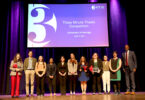The buying power of minority groups in the U.S. has reached new heights and continues to outpace cumulative inflation, according to the latest Multicultural Economy Report from the Selig Center for Economic Growth at the University of Georgia Terry College of Business.
The rising trend in minority buying power signals an opportunity for tailored marketing, according to Jeff Humphreys, director of the Selig Center and author of the report. For example, at $1.3 trillion the 2014 Hispanic market is larger than the economy of all but 15 countries in the world.
The report breaks down the economy by racial and ethnic affiliation, supplying buying power estimates for African Americans, Asians, Native Americans and Hispanics. It also includes state-by-state buying power projections, providing businesses with a blueprint for market growth across the U.S.
The term “buying power” refers to the total personal income of residents that is available after taxes. It does not included dollars that are borrowed or were previously saved. The full report is available for purchase at the Selig Center’s website for $125.
The Selig Center also offers a free report on Asian-American buying power. This report, also available on the center’s website, offers a more complete breakdown of Asian subgroups (such as Asian Indian, Chinese, Filipino and Laotian) and their economic clout.
Highlights from the 2014 Multicultural Economy report are:
African Americans
Black buying power will rise to $1.1 trillion in 2014. African Americans control the second biggest minority market, behind Hispanics. Black buying power has seen an 86 percent increase since 2000 and accounts for 8.7 percent of the nation’s total.
The growth in black buying power stems in part from an increase in the number of black-owned businesses as well as from an uptick in education among the African-American population, which leads to higher incomes.
Native Americans
The Native population will see their buying power increase 149 percent since 2000, to $100 billion. That increase is larger than the percentage growth in the white population, and is due in part to rapid growth of the Native American population.
Although Natives comprise only 1.3 percent of the total U.S. population, their buying power and clustered populations should make them especially attractive to businesses.
Asians
The Selig Center estimates that Asian buying power will rise to $770 billion in 2014, with 5.5 percent of the U.S. population claiming Asian ancestry. (This number includes those who identified as Asian as well as Native Hawaiian or Other Pacific Islander.)
Despite the Great Recession, employment gains for Asians grew 45 percent since 2000. Those strong gains coupled with a fast-growing immigrant population mean that Asian buying power is expected to grow to $1 trillion in 2019.
Hispanics
One of out every six people in the U.S. claims Hispanic origin, making the group an economic powerhouse. The $1.3 trillion 2014 Hispanic market shows a gain of 155 percent since 2000, which is far greater gain than the 71 percent increase in non-Hispanic buying power and the 76 percent increase in overall buying power since that time.
The Selig Center estimates that by 2019 Hispanics will account for 10.6 percent of total U.S. buying power.
Available for purchase from the Selig Center as a download, “The Multicultural Economy” estimates minority buying power by applying economic modeling and forecasting techniques to data from various U.S. government sources. The model developed by the Selig Center integrates statistical methods used in economic forecasting with those of marketing research.
The Terry College of Business
The University of Georgia Terry College of Business is consistently ranked among the top in the nation. Its faculty are committed to high-quality research and instruction, preparing students at every level for the global business community. Terry offers undergraduate business (BBA, AB-Econ), Full-Time MBA, Professional MBA, Executive MBA, Master of Accountancy, Master of Marketing Research, online Master of Internet Technology, Ph.D. and Executive programs. It is also home to the Selig Center for Economic Growth. For more information, see www.terry.uga.edu.








